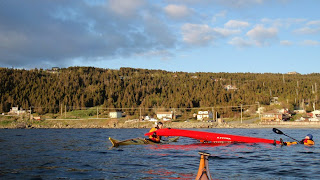7 hours ago
Friday, June 11, 2010
Assisted rescue disection
Last week I was in a similar position while completing an assisted rescue. I got into a position where the overturned boat wasn't perpendicular to me and had considerable trouble getting it onto my lap to dump the water out.
With the boats almost parallel its very difficult to get good leverage to lift the overturned kayak. It puts the rescuer in a precarious position because they can easily pull themselves over trying to do the lift.
The key to the assisted rescue is to get promptly to the overturned boat and at right angles to it. That means using the right paddle strokes to get into that position. Once there its possible to almost fall onto the overturned boat as leaning on it provides considerable stability while lifting out of the water. Speed is of the essence because waves can quickly move the overturned boat out of perpendicular.
Here Dean is dumping water out of Clyde's boat and its clear to see how stable the rescuer's boat is while using the other boat as a prop. The same holds for an overturned boat. The rescuer can safely lean onto the overturned boat in order to pull it up onto the combing to prepare for water dumping.
Clyde and Dean talk about the assisted rescue after completion. Discussion of what went right and what could be done better after the fact is always a good idea. It validates how the rescuer feels about the performance because the swimmer sees it from a different perspective. For example, the swimmer may be confused with the shock of having to wet exit and wanted more specific instructions from the rescuer.
Subscribe to:
Post Comments (Atom)




Of course, effectively breaking the suction of the cockpit is another major factor that must considered too.
ReplyDeleteLooks lke you had a nice evening on the water. Sorry I missed it!
Ya cockpit suction is what adds what feels like extra weight. That's why getting perpendicular is the key, especially if its a fully loaded boat.
ReplyDeleteTony :-)
Try this.
ReplyDeleteRight the boat without lifting it. It will collect some more water but it does not matter.
Get hold of the bow toggle, put the victim's boat at 90degs to your boat.
Push it as far away as you can, then pull it hard up onto your deck (it will probably ride up onto your deck easily because of the momentum and the curve of the bow) and as it comes up tilt it towards you using the deck lines.
The water will empty out the rear of the cockpit. Turn it correct way up and put it back in the water.
I can do this with a laden boat.
If the rescuer is struggling to pull the boat up the swimmer can assist by going to the opposite side of the rescue boat and pulling on his/her boat by bracing his/her feet against the rescuers hull.
I think there are good pictures in the BCU Manual but I cannot check 'cos I have loaned mine out.
If you have two rescue boats do the HI rescue. It is fast and stable, again see the BCU manual